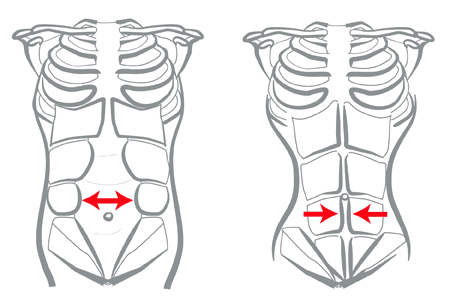DIASTASIS REHAB
LOSE YOUR MUMMY TUMMY®
Anyone can have a diastasis recti. This program is for women of all ages. It does not matter when or if you have ever had a baby. For men I teach Lose Your Gut Guys. Diastasis rehab is for everybelly.
Everyone is born with their outermost abdominal muscles separated. As the nervous system matures, the muscles usually close (around 3 yrs old), however, in 30% of the children it does not close. If it did close, the muscles can separate again doing exercises (crunches, pilates 100, yoga backbends, kickboxing) or sports (tennis, golf) that create continuous force and pressure on the connective tissue that joins the two separated muscles.
For pregnant women, the growing uterus creates a diastasis or makes this condition worse. With each subsequent pregnancy, a woman may show sooner as the muscles spread further apart and the connective tissue becomes weaker and weaker. Abdominal trauma leading to the tearing of the connective tissue away from the muscle can cause a ventral hernia and require surgery.
A sure sign of a diastasis is:
- When you are repeatedly asked if you’re pregnant…… when you’re not!
- Having an outie belly button. This is a side effect of a diastasis recti.
- Back problems. Connective tissue is not a good support system for your back.
- Gastrointestinal problems. The intestines are now supported by connective tissue instead of muscles.
The Tupler Technique® program is all about healing the connective tissue.
How to heal your diastasis in the 4 simple steps of the Tupler Technique®:
- Tupler Technique® Exercises (Elevator, Contracting & Headlifts)
- Splinting with the Diastasis Rehab Splint®
- Using your abdominals correctly with activities of daily living
- Getting up and down correctly
- Diastasis Rehab Lose Your Mummy Tummy®
- Diastasis Rehab Splint®
- Tupler Technique® Guidebook
- Dynaband
 |
| Muscles before working with ReclaimYourCore and after |
The Tupler Technique® Program runs over eighteen weeks. During the first six weeks you will learn the 4- step Tupler Technique® and then in week six of the program, once you have strengthened your transverse muscle, you will learn how to incorporate the Tupler Technique® into any exercise routine. So it is important to do JUST this program during the first six weeks! Walking is fine. You need to wear the splint until your diastasis is closed. Once it is closed you do not need to wear the splint. However, to prevent the diastasis from opening up again, you will need to continue doing the Tupler Technique® exercises.
EVERYTHING YOU WANT TO KNOW ABOUT A DIASTASIS
 DEFINITION OF DIASTASIS RECTI
DEFINITION OF DIASTASIS RECTI
The word diastasis means separation. So a diastasis recti is a separation of the rectus abdominis or the outermost abdominal muscles. When the muscles separate, the connective tissue that joins them stretches sideways. The more it stretches sideways the thinner and weaker it becomes.CAUSE OF DIASTASIS
Everyone is born with their muscles separated. Whether it closes depends on the amount of force or pressure on the connective tissue that joins the outermost muscles. If the muscles close, they are always at risk for separating again when there is this continuous force on the connective tissue. Force can be caused by:- Weight gain in the abdominal area
- Growing uterus during pregnancy
- Doing abdominal exercises incorrectly
For diastasis articles on the web go here
TEST yourself for Diastasis Recti!
1. Simply lie on your back with your knees bent and the soles of your feet flat on the ground.
2. Place one hand behind your head and one hand on your abdomen with fingertip at the level of your belly button and paralell to your waistline.
3. Relax abdominal muscles and slowly lift your head ( tilting head forward.) Bring your head back down. Do this a few times with 2 fingers pointed toward your toes, you are feeling for a ridge between the muscles.
4. If you don't feel a gap, try this with 3 or 4 fingers and make sure to keep abdominals relaxed. Find where the separation is widest.
5. Test for length (test the separation above, at, and below the belly button, find out the length of it
6. Test the depth by how far your fingers go "in" to your separation. they may go in just a finger nail (shallow) or to the middle knuckles (very deep).
7. if you are trying to heal your gap,dont test too often, only test every 1 to two weeks

